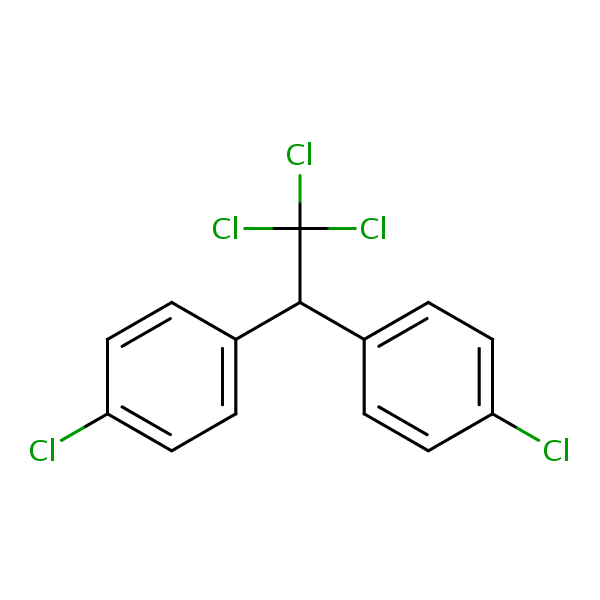p,p'-Dichlorodiphenyltrichloroethane (DDT)
CASRN 50-29-3 | DTXSID4020375
- IRIS Summary (PDF) (17 pp, 133 K)
- Status: EPA announced in a 2004 Federal Register Notice that chemicals used as pesticides would not be re-assessed by the IRIS Program. This entry in the IRIS database is preserved at the request of EPA program and regional offices. Additional toxicological information may be found under "Other EPA Information."
On this page:
Noncancer Assessment
Reference Dose for Oral Exposure (RfD) (PDF) (17 pp, 133 K) Last Updated: 03/31/1987
| System | RfD (mg/kg-day) | Basis | PoD | Composite UF | Confidence |
|---|---|---|---|---|---|
| Hepatic | 5 x 10 -4 | Liver lesions |
NOEL
:
5
x 10-2
mg/kg-day |
100 | Medium |
Reference Concentration for Inhalation Exposure (RfC) (PDF) (17 pp, 133 K)
Not assessed under the IRIS Program.
Cancer Assessment
Weight of Evidence for Cancer (PDF)
(17 pp, 133 K)
Last Updated: 08/22/1988
| WOE Characterization | Framework for WOE Characterization |
|---|---|
| B2 (Probable human carcinogen - based on sufficient evidence of carcinogenicity in animals) | Guidelines for Carcinogen Risk Assessment (U.S. EPA, 1986) |
- Observation of tumors (generally of the liver) in seven studies in various mouse strains and three studies in rats. DDT is structurally similar to other probable carcinogens, such as DDD and DDE.
- This may be a synopsis of the full weight-of-evidence narrative.
Quantitative Estimate of Carcinogenic Risk from Oral Exposure (PDF) (17 pp, 133 K)
Oral Slope Factor:
3.4
x 10-1
per mg/kg-day
Drinking Water Unit Risk:
9.7
x 10-6
per µg/L
Extrapolation Method: Linearized multistage procedure, extra risk
Tumor site(s): Hepatic
Tumor type(s): Liver tumors, benign and malignant (Turusov et al., 1973; Terracini et al., 1973; Thorpe and Walker, 1973; Tomatis and Turusov, 1975; Cabral et al., 1982; Rossi et al., 1977)
Quantitative Estimate of Carcinogenic Risk from Inhalation Exposure (PDF) (17 pp, 133 K)
Inhalation Unit Risk:
9.7
x 10-5
per µg/m3
Extrapolation Method: Linear multistage procedure, extra risk
Tumor site(s): Hepatic
Tumor type(s): Liver tumors, benign and malignant (Turusov et al., 1973; Terracini et al., 1973; Thorpe and Walker, 1973; Tomatis and Turusov, 1975; Cabral et al., 1982; Rossi et al., 1977)
Other EPA Information
- Human Health Benchmarks for Pesticides (HHBP). This database provides human health benchmarks for pesticides that may be present in drinking water.
- Office of Pesticide Programs Pesticide Chemical Search. This database provides links to health effects information and registration status for pesticides.
- Chemistry Dashboard. This database provides information on chemical structures, experimental and predicted physicochemical, and toxicity data.
Related Links
Critical Effects
Tumor Sites
Chemical Structure

Synonyms
- Agritan
- Anofex
- Arkotine
- Azotox
- Benzene, 1,1'-(2,2,2-trichloroethylidene)bis(4-chloro-)
- Bosan Supra
- Bovidermol
- Chlorophenothan
- Chlorophenothane
- Chlorophenotoxum
- Citox
- Clofenotane
- DDT
- Dedelo
- Deoval
- Detox
- Detoxan
- Dibovan
- Dichlorodiphenyltrichloroethane
- Dichlorodiphenyltrichloroethane (DDT)
- Dichlorodiphenyltrichloroethane, p,p'-
- Dicophane
- Didigam
- Didimac
- Diphenyltrichloroethane
- Dodat
- Dykol
- ENT 1,506
- Estonate
- Ethane, 1,1,1-trichloro-2,2-bis(p-chlorophenyl)-
- Genitox
- Gesafid
- Gesapon
- Gesarex
- Gesarol
- Guesapon
- Guesarol
- Gyron
- Havero-Extra
- Hildit
- Ivoran
- Ixodex
- Kopsol
- Micro DDT 75
- Mutoxin
- NA 2761
- NCI-C00464
- Neocid
- PEB1
- Parachlorocidum
- Pentachlorin
- Pentech
- Ppzeidan
- R50
- RCRA Waste Number u061
- Rukseam
- Santobane
- Tech DDT
- Trichlorobis(4-chlorophenyl)ethane
- Zeidane
- Zerdane
- alpha,alpha-Bis(p-chlorophenyl)-beta,beta,beta-trichlorethane
- p,p'-DDT
- 1,1,1-Trichloor-2,2-bis(4-chloor fenyl)-ethaan
- 1,1,1-Trichlor-2,2-bis(4-chlor-phenyl)-aethan
- 1,1,1-Trichloro-2,2-bis(p-chlorophenyl)ethane
- 1,1,1-Trichloro-2,2-di(4-chlorophenyl)-ethane
- 1,1,1-Tricloro-2,2-bis(4-cloro-fenil)-etano
- 1,1-Bis-(p-chlorophenyl)-2,2,2-trichloroethane
- 2,2-Bis(p-chlorophenyl)-1,1,1-trichloroethane
- 4,4'-Dichlorodiphenyltrichloroethane
- 50-29-3


